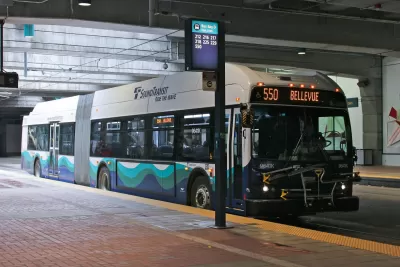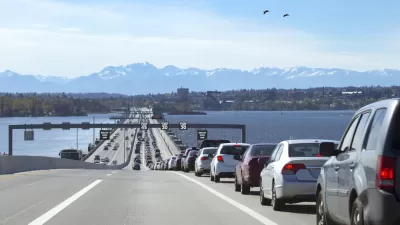The 2017 survey shows that most people drive, but income and housing location also affect people’s options and choices.

Stephen Fesler reports on the Puget Sound Regional Council’s release of its 2017 household travel survey data. The survey gathered information on travel behavior, parking and transit costs, and the factors related to mode choice.
It finds that most people, over 80 percent, have free parking at work, and high-income workers have more access to subsidized transit passes. “Larger employers–which tend to be higher paying–are required to create a [Commute Trip Reduction] program for employees. These programs often include subsidized or free transit passes. However, that often leaves lower-income individuals without cheaper transit options unless they qualify for ORCA LIFT, a reduced fare program that King County launched in 2015,” writes Fesler. In addition, the majority of transit users are reaching transit on foot.
Most people across all income levels drive, but lower-income households are more likely to walk or use transit, the survey shows. Fesler describes the mode choice differences by race:
Asians had the highest drive-alone and biking rates while reporting lower shared driving trips. Black, Latino, and other multiracial households reported double the transit rate, substantially lower drive-alone rates, and higher shared driving trips. Caucasian households had the lowest transit use rates, but otherwise were middle of the pack for other modes.
The survey also examines the ways in which housing affects mode choice. People living in Seattle’s regional growth centers—higher density, mixed-use areas—are more likely to walk or use transit and less likely to drive than people living in centers outside of Seattle or those not living in centers.
In addition, most of the lower-income respondents report that living in a walkable area near activities is important to them. “This was increasingly less important to middle-income and higher-income households. It seems very likely that this is related to regular access to a car, which very low-income households generally lack,” notes Fesler. A similar income pattern emerged in terms of the importance of close transit, with a majority of low-income respondents indicating this was important.
FULL STORY: PSRC’s 2017 Travel Survey Shows Transit Is Popular, Free Parking Induces Driving

Planetizen Federal Action Tracker
A weekly monitor of how Trump’s orders and actions are impacting planners and planning in America.

San Francisco's School District Spent $105M To Build Affordable Housing for Teachers — And That's Just the Beginning
SFUSD joins a growing list of school districts using their land holdings to address housing affordability challenges faced by their own employees.

The Tiny, Adorable $7,000 Car Turning Japan Onto EVs
The single seat Mibot charges from a regular plug as quickly as an iPad, and is about half the price of an average EV.

Seattle's Plan for Adopting Driverless Cars
Equity, safety, accessibility and affordability are front of mind as the city prepares for robotaxis and other autonomous vehicles.

As Trump Phases Out FEMA, Is It Time to Flee the Floodplains?
With less federal funding available for disaster relief efforts, the need to relocate at-risk communities is more urgent than ever.

With Protected Lanes, 460% More People Commute by Bike
For those needing more ammo, more data proving what we already knew is here.
Urban Design for Planners 1: Software Tools
This six-course series explores essential urban design concepts using open source software and equips planners with the tools they need to participate fully in the urban design process.
Planning for Universal Design
Learn the tools for implementing Universal Design in planning regulations.
Smith Gee Studio
City of Charlotte
City of Camden Redevelopment Agency
City of Astoria
Transportation Research & Education Center (TREC) at Portland State University
US High Speed Rail Association
City of Camden Redevelopment Agency
Municipality of Princeton (NJ)




























